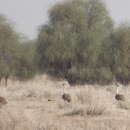Biology
provided by Arkive
In the 19th century, flocks of more than 20 birds were a common site on Indian grasslands but today groups are unlikely to number more than 3 individuals (5). Little is known about the breeding ecology of the great Indian bustard. Although it is possible for breeding to take place year-round, it seems to be mainly dictated by the monsoon (5). Nests are situated in the open ground and males take no part in incubation or care of the developing young; only a single egg is usually laid (5). The fledglings tend to remain with their mother until the following breeding season (5).
Great Indian bustards are opportunists, feeding on a wide range of items depending on their seasonal availability. Invertebrates such as grasshoppers and beetles are the preferred diet but in leaner times these are substituted with seeds such as Bengal gram, groundnut and soeha (5).
Conservation
provided by Arkive
The great Indian bustard is listed in Schedule I of the Wildlife (Protection) Act of 1972 in India and international trade is prohibited by its listing on Appendix I of the Convention on International Trade in Endangered Species (CITES) (5). A number of sanctuaries have been set up with the aim of preserving this species; however, this may not be the most effective means of conservation, as population numbers have continued to decline. The Bombay Natural History Society (BNHS) is urging the Indian Government to adopt a 'Project Bustard' scheme along the same lines of 'Project Tiger' (6). Such a high-profile project would be invaluable for raising awareness about the plight of India's 4 bustard species, and would be an important method of preserving the arid grassland habitat that is currently poorly protected in this country (6).
Description
provided by Arkive
The great Indian bustard is a tall, long legged bird. The underparts and neck are white, there is a black crown on the forehead and the upperbody is brown (2). The wings are marked with black, brown and grey (2). The sexes are similar in appearance although males have a larger black crown, long hind crown feathers and a black band across the breast (2).
Habitat
provided by Arkive
Found in dry grasslands and scrub where there are scattered bushes and some cultivation (2).
Range
provided by Arkive
Previously widespread and common across the Indian subcontinent, this species has today all but disappeared from Pakistan and populations in India are severely reduced (5).
Status
provided by Arkive
Classified as Endangered (EN – C1+2b) on the IUCN Red List 2002 (1), and listed on Appendix I of CITES (3).
Threats
provided by Arkive
The great Indian bustard has become extinct in almost 90% of its former range, principally as a result of loss of habitat and poaching (6). The conversion of the land for agriculture and widespread hunting, which became more prevalent with the onset of vehicle transport, have both contributed to the precipitous decline in this species (2).

